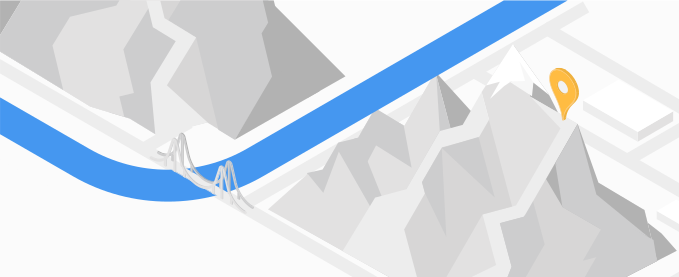
Interfejs Elevation API to usługa, która zwraca dane o wysokości położenie na Ziemi lub próbkowane dane o wysokości na ścieżkach.
Dlaczego warto korzystać z interfejsu Elevation API
Za pomocą interfejsu Elevation API możesz tworzyć aplikacje obsługujące klienci korzystający z aktywności zależnej od wysokości n.p.m., aplikacji pozycjonujących i mających poziom usług aplikacje obejmujące wartości ukształtowania terenu wzdłuż tras. Przykład: możesz podać dane o wzrostach i stratach, aby ulepszyć aplikację sportową do takich aktywności jak podczas wędrówek, jazdy na rowerze czy nurkowania.
Do czego służy interfejs Elevation API
Za pomocą interfejsu Elevation API możesz uwzględnić dane o wysokości w swoich danych lub na mapie. Na przykład:
- Sprawdź wysokość konkretnego miejsca.
- Oblicz różnice wysokości wzdłuż trasy lub między dwoma pkt.
Jak działa interfejs Elevation API
Interfejs Elevation API akceptuje żądanie w postaci zakodowanego adresu URL ze współrzędnymi szerokości i długości geograficznej mogą być określane jako osobne lokalizacje lub ciągi wzdłuż ścieżki. Żądanie to, na przykład zapytania o wysokość względną w centrum Denver w stanie Kolorado, które określają zwrot w formacie JSON.https://maps.googleapis.com/maps/api/elevation/json ?locations=39.7391536%2C-104.9847034 &key=YOUR_API_KEY
Usługa pobiera wysokość dla podanych współrzędnych. A także interpoluje wysokość dla lokalizacji bez ukształtowania terenu, zapewniając średnią wartość uzyskaną z czterech najbliższe lokalizacje, które oferują dane o wysokości n.p.m. Określa też ogólny dla danej lokalizacji.
Zasoby
W tabeli poniżej znajdziesz podsumowanie zasobów dostępnych w interfejsu Elevation API wraz z zwracanymi danymi.
| Zasoby danych | Zwrócone dane | Format zwrotu |
|---|---|---|
| Współrzędne szerokości i długości geograficznej
Dane możesz podać jako zbiór danych z jednej lub kilku lokalizacji albo seria wzdłuż ścieżki. Ty może też podać zakodowane współrzędne. Możesz przekazać do 512 współrzędnych. |
Interfejs Elevation API określa względną wysokość w metrach. do lokalnego średniego poziomu morza (LMSL). Wysokość może być zwracana jako wartość dodatnia lub wartości ujemne, jak podano poniżej:
|
|
Jak korzystać z interfejsu Elevation API
| 1 | Rozpocznij konfigurację. | Zacznij od skonfigurowania Projekt Google Cloud i dokończ konfigurację. z podanych instrukcji. |
| 2 | Wyślij prośbę o podniesienie wysokości | Po uzyskaniu klucza interfejsu API możesz zacząć testować interfejs Elevation API bezpośrednio na stronie przeglądarki. Zobacz przykładowe żądania. w przewodniku Pierwsze kroki. |
| 3 | Tworzenie bardziej złożonego żądania | Po skonfigurowaniu projektu możesz wysłać żądanie, które dostarcza danych o lokalizacji ścieżki konwersji. Patrz Określanie ścieżek . |
| 4 | Podstawowe informacje o odpowiedziach | Zapoznaj się z odpowiedziami dotyczącymi danych o wysokości, aby przygotować się do użycia takich danych w przypadku aplikacji. Zobacz Odpowiedzi dotyczące wysokości względnej . |
| 5 | Dodaj dane o wysokości do własnej aplikacji. | Dzięki danym o wysokości możesz zwiększyć skuteczność aplikacji korzystających z lokalizacji, np. aplikacji sportowych aktywności ani danych ankietowych. |
Dostępne biblioteki klienta
Wywołaj ten interfejs API w języku możesz wybrać za pomocą jednej z tych bibliotek klienta:
- Java Klient usług Map Google
- Python. Klient usług Map Google
- Klient Go w przypadku usług Map Google
- Node.js Klient usług Map Google
klient Java, Python, Go i Node.js dla Map Google; Usługi to obsługiwane przez społeczność biblioteki klienckie udostępniane na zasadach open source Licencja Apache 2.0 Pobierz je z GitHuba, gdzie znajdziesz też instrukcje instalacji i przykładowy kod.
Co dalej?
- Zacznij korzystać z interfejsu Elevation API: otwórz Skonfiguruj Projekt Google Cloud.
- Spróbuj pobrać dane o wysokości zależnej od ścieżki: kliknij Określanie ścieżek
- Stosuj sprawdzone metody: przejdź do sekcji Usługa internetowa Sprawdzone metody

